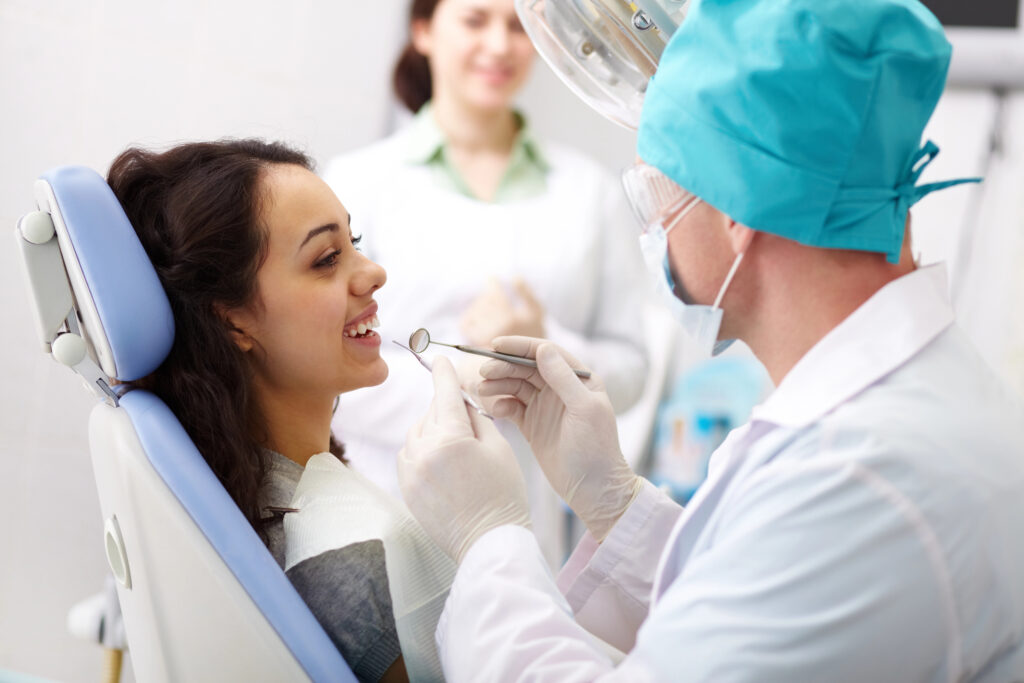
When you sit down in the dental chair for your twice-a-year check-up, you probably expect your dentist to clean your teeth, maybe take a few X-rays, and send you on your way with a new toothbrush.
But there’s actually a lot more happening during that routine exam than you might think. Here are just some of the things you might not realize your dentist is doing while you’re in the chair.
1. Checking for Signs of Oral Cancer
One of the most important parts of your dental exam has nothing to do with your teeth. Your dentist is also checking for signs of oral cancer. This includes examining your lips, tongue, throat, and the inside of your cheeks for any unusual lumps, patches, or sores.
Oral cancer is a serious disease that can be life-threatening if not caught early. But the good news is that survival rates are high when oral cancer is detected and treated in its early stages. Your dentist is trained to spot the subtle signs that might be missed by the untrained eye.
2. Evaluating Your Bite and Jaw Alignment
Your dentist isn’t just looking at individual teeth – they’re also assessing how your teeth fit together when you bite down. This is known as your occlusion or bite alignment.
We are always checking for any areas of excessive wear or uneven pressure, which can be a sign of misaligned teeth, jaw problems, or teeth grinding. Catching bite issues early can help prevent more serious problems down the road, like chronic jaw pain, headaches, or even tooth fractures.
3. Assessing Your Risk for Periodontal Disease
Periodontal disease, also known as gum disease, is a serious infection that can lead to tooth loss if left untreated. During your exam, your dentist is carefully evaluating your gums for any signs of inflammation, redness, or bleeding.
We’re also checking the depth of the pockets between your teeth and gums. Healthy pockets should be no more than 3 millimeters deep. Deeper pockets can indicate periodontal infection.
Based on these findings, we can determine your risk for developing gum disease and recommend an appropriate course of treatment or preventive care.
4. Looking for Signs of Tooth Decay
Of course, one of the main things your dentist is checking for during your exam is cavities. But did you know we’re not just looking at the chewing surfaces of your teeth?
We will carefully examine all surfaces of each tooth, including the hard-to-see areas between teeth and along the gum line. We may use special tools to check for any soft or sticky spots that could indicate decay.
If we do find a cavity, we’ll assess how deep it is and recommend the appropriate treatment, such as a filling or crown.
5. Checking Your Fillings, Crowns, and Other Restorations
If you have any existing dental work, like fillings, crowns, bridges, or implants, your dentist will give them a thorough check-up during your exam. We’re looking for any signs of wear, damage, or decay around the margins of these restorations.
Over time, fillings can sometimes crack or fall out, allowing bacteria to seep in and cause new cavities. Crowns and bridges can also become loose or develop decay underneath them. By identifying these issues early, we hope to help you avoid more extensive (and expensive) problems down the road.
6. Reviewing Your Medical History and Medications
Before starting your exam, your dentist or hygienist will likely ask if there have been any changes to your medical history or medications since your last visit. This isn’t just small talk – certain health conditions and medications can have a big impact on your oral health.
For example, diabetes can increase your risk for gum disease, while medications that cause dry mouth can lead to more cavities. By staying up-to-date on your overall health, we can tailor our recommendations and treatments to your unique needs.
7. Making Personalized Recommendations for Your Oral Hygiene
Based on what we see and discuss during your exam, we will offer customized advice for your at-home oral care routine. This might include recommendations for a specific toothpaste or rinse, tips for perfecting your brushing technique, or suggestions for addressing any problem areas.
We can also recommend the right tools for your needs, such as an electric toothbrush, water flosser, or interdental brushes for cleaning between teeth.
8. Answering Your Questions and Addressing Your Concerns
Finally, your dental exam is the perfect time to bring up any questions or concerns you have about your oral health. Are you considering cosmetic treatments like whitening or veneers? Wondering if you’re a candidate for Invisalign? Noticing tooth sensitivity or bleeding gums?
We are Here for Your Oral Health
We are here to help! We love it when patients take an active interest in their oral health, and we’re always happy to provide guidance and support.
Give us a call today to schedule your next appointment.